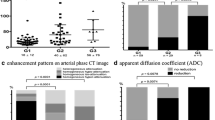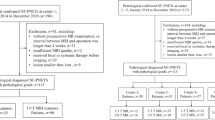Abstract
Objectives
To evaluate the value of MR imaging including diffusion-weighted imaging (DWI) for the grading of pancreatic neuroendocrine tumours (pNET).
Material and Methods
Between 2006 and 2014, all resected pNETs with preoperative MR imaging including DWI were included. Tumour grading was based on the 2010 WHO classification. MR imaging features included size, T1-w, and T2-w signal intensity, enhancement pattern, apparent (ADC) and true diffusion (D) coefficients.
Results
One hundred and eight pNETs (mean 40 ± 33 mm) were evaluated in 94 patients (48 women, 51 %, mean age 52 ± 12). Fifty-five (51 %), 42 (39 %), and 11 (10 %) tumours were given the following grades (G): G1, G2, and G3. Mean ADC and D values were significantly lower as grade increased (ADC: 2.13 ± 0.70, 1.78 ± 0.72, and 0.86 ± 0.22 10-3 mm2/s, and D: 1.92 ± 0.70, 1.75 ± 0.74, and 0.82 ± 0.19 10-3 mm2/s G1, G2, and G3, all p < 0.001). A higher grade was associated with larger sized tumours (p < 0.001). The AUROC of ADC and D to differentiate G3 and G1-2 were 0.96 ± 0.02 and 0.95 ± 0.02. Optimal cut-off values for the identification of G3 were 1.19 10-3 mm2/s for ADC (sensitivity 100 %, specificity 92 %) and 1.04 10-3 mm2/s for D (sensitivity 82 %, specificity 92 %).
Conclusion
Morphological/functional MRI features of pNETS depend on tumour grade. DWI is useful for the identification of high-grade tumours.
Key Points
• Morphological and functional MRI features of pNETs depend on tumour grade.
• Their combination has a high predictive value for grade.
• All pNETs should be explored by MR imaging including DWI.
• DWI is helpful for identification of high-grade and poorly-differentiated tumours.





Similar content being viewed by others
Change history
04 June 2020
The original version of this article, published on 19 August 2016, unfortunately contained a mistake.
Abbreviations
- ADC:
-
apparent diffusion coefficient
- D:
-
true diffusion coefficient
- DWI:
-
diffusion-weighted imaging
- ENETS:
-
European Neuroendocrine Tumour Society
- G:
-
grade
- (p)NET:
-
(pancreatic) neuroendocrine tumour
- MRI:
-
magnetic resonance imaging
- WHO:
-
World Health Organization
References
Zerbi A, Falconi M, Rindi G et al (2010) Clinicopathological features of pancreatic endocrine tumors: a prospective multicenter study in Italy of 297 sporadic cases. Am J Gastroenterol 105:1421–1429
Kloppel G (2011) Classification and pathology of gastroenteropancreatic neuroendocrine neoplasms. Endocr-Relat Cancer 18:S1–S16
Klimstra DS, Modlin IR, Coppola D, Lloyd RV, Suster S (2010) The pathologic classification of neuroendocrine tumors: a review of nomenclature, grading, and staging systems. Pancreas 39:707–712
Kloppel G, Rindi G, Perren A, Komminoth P, Klimstra DS (2010) The ENETS and AJCC/UICC TNM classifications of the neuroendocrine tumors of the gastrointestinal tract and the pancreas: a statement. Virchows Arch Int J Pathol 456:595–597
Plockinger U, Rindi G, Arnold R et al (2004) Guidelines for the diagnosis and treatment of neuroendocrine gastrointestinal tumours. A consensus statement on behalf of the European Neuroendocrine Tumour Society (ENETS). Neuroendocrinology 80:394–424
Scarpa A, Mantovani W, Capelli P et al (2010) Pancreatic endocrine tumors: improved TNM staging and histopathological grading permit a clinically efficient prognostic stratification of patients. Mod Pathol 23:824–833
Bettini R, Boninsegna L, Mantovani W et al (2008) Prognostic factors at diagnosis and value of WHO classification in a mono-institutional series of 180 non-functioning pancreatic endocrine tumours. Ann Oncol 19:903–908
Ramage JK, Ahmed A, Ardill J et al (2012) Guidelines for the management of gastroenteropancreatic neuroendocrine (including carcinoid) tumours (NETs). Gut 61:6–32
Bilimoria KY, Tomlinson JS, Merkow RP et al (2007) Clinicopathologic features and treatment trends of pancreatic neuroendocrine tumors: analysis of 9,821 patients. J Gastrointest Surg 11:1460–1467, discussion 1467–1469
Alexiev BA, Darwin PE, Goloubeva O, Ioffe OB (2009) Proliferative rate in endoscopic ultrasound fine-needle aspiration of pancreatic endocrine tumors: correlation with clinical behavior. Cancer 117:40–45
Rebours V, Cordova J, Couvelard A et al (2015) Can pancreatic neuroendocrine tumour biopsy accurately determine pathological characteristics? Dig Liver Dis. doi:10.1016/j.dld.2015.06.005
Weynand B, Borbath I, Bernard V et al (2014) Pancreatic neuroendocrine tumour grading on endoscopic ultrasound-guided fine needle aspiration: high reproducibility and inter-observer agreement of the Ki-67 labelling index. Cytopathol Off J Br Soc Clin Cytol 25:389–395
Hasegawa T, Yamao K, Hijioka S et al (2014) Evaluation of Ki-67 index in EUS-FNA specimens for the assessment of malignancy risk in pancreatic neuroendocrine tumors. Endoscopy 46:32–38
Bettini R, Partelli S, Boninsegna L et al (2011) Tumor size correlates with malignancy in nonfunctioning pancreatic endocrine tumor. Surgery 150:75–82
Manfredi R, Bonatti M, Mantovani W et al (2013) Non-hyperfunctioning neuroendocrine tumours of the pancreas: MR imaging appearance and correlation with their biological behaviour. Eur Radiol 23:3029–3039
Cappelli C, Boggi U, Mazzeo S et al (2015) Contrast enhancement pattern on multidetector CT predicts malignancy in pancreatic endocrine tumours. Eur Radiol 25:751–759
Koito K, Namieno T, Nagakawa T, Morita K (1997) Delayed enhancement of islet cell carcinoma on dynamic computed tomography: a sign of its malignancy. Abdom Imaging 22:304–306
d'Assignies G, Couvelard A, Bahrami S et al (2009) Pancreatic endocrine tumors: tumor blood flow assessed with perfusion CT reflects angiogenesis and correlates with prognostic factors. Radiology 250:407–416
Kim DW, Kim HJ, Kim KW et al (2015) Neuroendocrine neoplasms of the pancreas at dynamic enhanced CT: comparison between grade 3 neuroendocrine carcinoma and grade 1/2 neuroendocrine tumour. Eur Radiol 25:1375–1383
Rodallec M, Vilgrain V, Couvelard A et al (2006) Endocrine pancreatic tumours and helical CT: contrast enhancement is correlated with microvascular density, histoprognostic factors and survival. Pancreatology 6:77–85
Kim DW, Kim HJ, Kim KW et al (2016) Prognostic value of CT findings to predict survival outcomes in patients with pancreatic neuroendocrine neoplasms: a single institutional study of 161 patients. Eur Radiol 26:1320–1329
Kim JH, Eun HW, Kim YJ, Lee JM, Han JK, Choi BI (2016) Pancreatic neuroendocrine tumour (PNET): Staging accuracy of MDCT and its diagnostic performance for the differentiation of PNET with uncommon CT findings from pancreatic adenocarcinoma. Eur Radiol 26:1338–1347
Park HS, Kim SY, Hong SM et al (2016) Hypervascular solid-appearing serous cystic neoplasms of the pancreas: differential diagnosis with neuroendocrine tumours. Eur Radiol 26:1348–1358
Barral M, Sebbag-Sfez D, Hoeffel C et al (2013) Characterization of focal pancreatic lesions using normalized apparent diffusion coefficient at 1.5-Tesla: preliminary experience. Diagn Interv Imaging 94:619–627
Kang KM, Lee JM, Yoon JH, Kiefer B, Han JK, Choi BI (2014) Intravoxel incoherent motion diffusion-weighted MR imaging for characterization of focal pancreatic lesions. Radiology 270:444–453
Brenner R, Metens T, Bali M, Demetter P, Matos C (2012) Pancreatic neuroendocrine tumor: added value of fusion of T2-weighted imaging and high b-value diffusion-weighted imaging for tumor detection. Eur J Radiol 81:e746–e749
d'Assignies G, Fina P, Bruno O et al (2013) High sensitivity of diffusion-weighted MR imaging for the detection of liver metastases from neuroendocrine tumors: comparison with T2-weighted and dynamic gadolinium-enhanced MR imaging. Radiology 268:390–399
Wang Y, Chen ZE, Yaghmai V et al (2011) Diffusion-weighted MR imaging in pancreatic endocrine tumors correlated with histopathologic characteristics. J Magn Reson Imaging 33:1071–1079
Jang KM, Kim SH, Lee SJ, Choi D (2014) The value of gadoxetic acid-enhanced and diffusion-weighted MRI for prediction of grading of pancreatic neuroendocrine tumors. Acta Radiol 55:140–148
Pereira JA, Rosado E, Bali M, Metens T, Chao SL (2015) Pancreatic neuroendocrine tumors: correlation between histogram analysis of apparent diffusion coefficient maps and tumor grade. Abdom Imaging 40:3122–3128
Birnbaum DJ, Gaujoux S, Cherif R et al (2014) Sporadic nonfunctioning pancreatic neuroendocrine tumors: prognostic significance of incidental diagnosis. Surgery 155:13–21
Gaujoux S, Partelli S, Maire F et al (2013) Observational study of natural history of small sporadic nonfunctioning pancreatic neuroendocrine tumors. J Clin Endocrinol Metab 98:4784–4789
Kishi Y, Shimada K, Nara S, Esaki M, Hiraoka N, Kosuge T (2014) Basing treatment strategy for non-functional pancreatic neuroendocrine tumors on tumor size. Ann Surg Oncol 21:2882–2888
Hwang EJ, Lee JM, Yoon JH et al (2014) Intravoxel incoherent motion diffusion-weighted imaging of pancreatic neuroendocrine tumors: prediction of the histologic grade using pure diffusion coefficient and tumor size. Invest Radiol 49:396–402
Luo Y, Dong Z, Chen J et al (2014) Pancreatic neuroendocrine tumours: correlation between MSCT features and pathological classification. Eur Radiol 24:2945–2952
Gratian L, Pura J, Dinan M, Roman S, Reed S, Sosa JA (2014) Impact of extent of surgery on survival in patients with small nonfunctional pancreatic neuroendocrine tumors in the United States. Ann Surg Oncol 21:3515–3521
Klau M, Mayer P, Bergmann F et al (2015) Correlation of histological vessel characteristics and diffusion-weighted imaging intravoxel incoherent motion-derived parameters in pancreatic ductal adenocarcinomas and pancreatic neuroendocrine tumors. Invest Radiol 50:792–797
Surov A, Caysa H, Wienke A, Spielmann RP, Fiedler E (2015) Correlation between different ADC fractions, cell count, Ki-67, total nucleic areas and average nucleic areas in meningothelial meningiomas. Anticancer Res 35:6841–6846
Karaman A, Durur-Subasi I, Alper F et al (2015) Correlation of diffusion MRI with the Ki-67 index in non-small cell lung cancer. Radiol Oncol 49:250–255
Yao JC, Hassan M, Phan A et al (2008) One hundred years after “carcinoid”: epidemiology of and prognostic factors for neuroendocrine tumors in 35,825 cases in the United States. J Clin Oncol 26:3063–3072
Acknowledgments
The scientific guarantor of this publication is Maxime Ronot. The authors of this manuscript declare no relationships with any companies, whose products or services may be related to the subject matter of the article. The authors state that this work has not received any funding. No complex statistical methods were necessary for this paper. Institutional Review Board approval was obtained. Written informed consent was waived by the Institutional Review Board. Methodology: retrospective, diagnostic or prognostic study, performed at one institution.
Author information
Authors and Affiliations
Corresponding author
Electronic supplementary material
Below is the link to the electronic supplementary material.
Supplemental Figure 1
Example of a G1 pNET of the head of the pancreas in a 58 yo female. MR imaging showed a small (< 2 cm) hypervascular tumour on arterial phase images (arrow in a) with high signal intensity on high b value diffusion-weighted images (b=600 s/mm2) (arrow in b), and a mean ADC value of 2.30 10-3 mm2/s (c). All features were consistent with a G1 tumour. The lesion was resected, and pathological analysis confirmed the tumour grade (Ki67 < 1%). (GIF 26 kb)
(GIF 23 kb)
(GIF 34 kb)
Supplemental Figure 2
Proposition of classification algorithm for the prediction of tumour grade. The right hand side column represents the mean (and standard deviation) of each box. (GIF 21 kb)
ESM 1
(DOCX 15 kb)
Rights and permissions
About this article
Cite this article
Lotfalizadeh, E., Ronot, M., Wagner, M. et al. Prediction of pancreatic neuroendocrine tumour grade with MR imaging features: added value of diffusion-weighted imaging. Eur Radiol 27, 1748–1759 (2017). https://doi.org/10.1007/s00330-016-4539-4
Received:
Revised:
Accepted:
Published:
Issue Date:
DOI: https://doi.org/10.1007/s00330-016-4539-4




